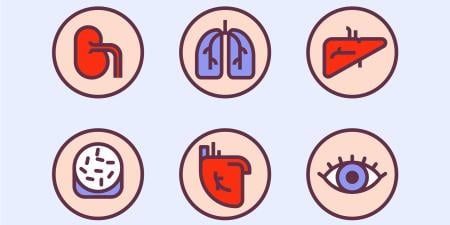Johnson EJ, Goldstein DG. Defaults and donation decisions.Transplantation. 2004;78(12):1713-1716.
The Supply-Demand Problem
The statistics in the US are staggering. At the end of 2003, more than 82 000 patients remained on the waiting list for solid organ transplants. In that same year, 7000 people died while waiting, and 13 285 people (6457 deceased and 6828 living) donated organs that resulted in just over 25 000 transplants.1,2
Clearly, the demand for organs continues to outstrip the supply, and there is no sign of this trend slowing. The number of organ donors has been increasing yearly, but much of that can be attributed to the growing number of living donors, which has surpassed the number of deceased donors since 2001. The number of deaths (based on brain death criteria) that result in eligible organ donors has remained stagnant since 2002 at approximately 12 000.1
One can become mired in the statistics of organ donation; the portrait painted by the data frustrates everyone from economists to patients, from politicians to physicians. With data analyses in hand, scholars from a wide array of disciplines have attacked this supply-demand problem vociferously, offering a host of possible solutions, primarily directed toward increasing the supply of organs. Lately, they have switched their attention from the rather unchanging "eligible death" donor pool to living donors and donations after cardiac death, alternatives which have shown clinical success with specific organs but for which the clinical potential is still limited.
Yet, the paramount goal of the transplant community for many years—increasing cadaveric organ donations from eligible donors—remains largely unattainable. In fact, only 49.8 percent of the eligible cadaveric donors become actual donors.1 Based on 2003 statistics, each cadaveric donor provided, on average, 3 organs for transplantation. So we could reliably predict that, if all (rather than half) of the 12 000 eligible donors became actual donors, cadaveric organ transplants would double from 18 000 (3 organs from 6000 donors) to 36 000—a very substantial increase.
Deciding to Donate
A widely cited 1993 Gallup poll of 6127 Americans discovered that 85 percent supported donation and that 69 percent were either very or somewhat likely to want to have their organs donated after their death.3 A 1999 Pew Research Center survey of 1013 Americans found that 81 percent were in support of donation and that 67 percent were either very or somewhat likely to want their organs donated after their death.4 These 2 surveys asked the same questions 6 years apart and garnered nearly the same results: support for organ donation was at 81-85 percent, but only two-thirds of those surveyed said they were likely to want their organs donated after their death. More than 25 percent reported that they would most likely not want to donate.
Eric Johnson and Daniel Goldstein, professors at Columbia University's Center for the Decision Sciences, offer a unique perspective on how to increase the supply of this life-saving resource: focus on how the decision to donate is framed. Challenging the assumption that Americans, in general, "have reached a decision not to donate," the authors argue in their 2004 article, "Defaults and Donation Decisions," that people often construct their preferences based on when and how the question is asked.5 The authors performed an experimental online survey to test this hypothesis and discover how the framing of the question about willingness to donate organs might influence the result. The authors asked 161 respondents whether they would donate their organs, using 1 of 3 different questions:
- Participants are told to assume they had just moved to a state where the default was to not be an organ donor. Choice: confirm that they did not want to donate or change that status.
- Participants are told to assume they had just moved to a state where the default was to be an organ donor. Choice: confirm that they wanted to donate or change that status.
- Participants were required to choose whether they wanted to donate or not, with no prior default position. Choice: I want to donate my organs or I do not want to donate my organs.5
Option 1 mirrors the "opt-in" or "explicit-consent" model currently used in the United States. Option 2 represents the "opt-out" or "presumed-consent" model employed by a number of European countries. And one might say that Option 3 resembles the questions from the Gallop and Pew Surveys—a neutral question that requires an active choice.
While the sample set was small, the results of Johnson and Goldstein's experiment sheds valuable light on the apparent gap between the overall opinions of Americans and the actual donor consent rate. Options 2 and 3 resulted in donation consent rates of 82 percent and 79 percent, respectively. In stark contrast, Option 1 yielded only a 42 percent consent rate. The authors use the experimental consent rates coupled with a statistical comparison of consent rates in "opt-in" versus "opt-out" European countries as support for their theory that donation decisions are strongly influenced by whether the default position is donation or nondonation. This is troubling because it suggests that how the question is asked plays a greater role in the respondents' decision than actual preference for or against donation. As the authors put it, "If preferences concerning organ donation [were] strong, defaults should have little or no effect."5
Johnson and Goldstein review a number of ways that defaults have been shown to influence individual choices, no matter what the decision at hand: (1) defaults may be seen as a recommendation from policy makers; (2) accepting the default is effortless while making a decision requires effort; (3) defaults represent the status quo, and changing usually involves a trade-off—giving up one thing for another. Regarding the latter point, the authors note that "psychologists have shown that losses loom larger than the equivalent gains" (a phenomenon they call "loss aversion"); and this increased weight given to whatever is forgone makes the default position seem more attractive.5
Applying this psychology to the US opt-in system, changing one's status to become a donor would be seen, Johnson and Goldstein write, as a "tradeoff between a gain ([the] satisfaction [of donating]) and a loss (the possible negative [body] imagery)."5 The authors conclude with 2 important observations unique to organ donation decision making. First, the reason for the difference between the high abstract approval rates of organ donation compared to the actual consent rates is that most Americans have not yet made or acted upon a decision about organ donation. If they had, framing the question in different ways would not elicit such different results. Because this is true, the authors conclude that how the choice is framed—ie, whether the default position is opting in or opting out—will determine the outcome of the decision-making procedure far more dramatically than the offering of incentives—economic or otherwise. Second, the authors believe that the "cognitive cost" present in all decision making is higher in the case of organ donation because constructing a choice in this instance requires people to confront their own death—a scenario most wish to avoid contemplating. The authors cite the "mandated-choice" experiment in Virginia as evidence of people's reluctance to choose, since more than 24 percent of the people refused to make a decision about organ donation in that experiment.6
Constructing a Preference Is a Process.
Johnson and Goldstein have added a unique perspective to the organ transplant policy debates in this country through their application of decisional theory. Many in the transplant community believe that a shift in US policy to an opt-out or a modified version of the presumed-consent model is unlikely, but Johnson and Goldstein's observations can still be helpful without a formal US policy shift. I believe the authors' more important contribution lies in their relatively unexplored initial premise "that the way in which a request to become a donor is framed will influence the outcome."5 A first read of Johnson and Goldstein's essay may lead one to assume, based upon their experiment, that decisions are instantaneous. One may further suppose that if the default is not woven into a single question, it cannot have the desired effect. But a closer reading of the article reveals that, in fact, the construction of preference is a process, and this process is significantly influenced by the way the default choice is framed.
Through an understanding of the current practicalities of cadaveric organ donation—eg, that regardless of whether or not you sign an organ donor card your family members or surrogates have the final decision as to whether to donate your organs—we see that organ donation most frequently occurs after a conversation between one's family members and an organ procurement organization (OPO) representative (organ donation expert). Thus, most Americans are not faced with making a real decision about cadaveric donation of their own organs but rather one about cadaveric donation of their loved one's organs. When we consider additionally that most Americans have not yet made a decision about organ donation (let alone about donating a loved one's organs), the importance of the organ donation conversation initiated by the OPO representative becomes even greater. This conversation provides the time and the opportunity to construct preferences in the manner described by Johnson and Goldstein, and the impact of defaults on the donation decision remains the same no matter who serves as the decision maker. What the OPO representative, as an informative expert in organ donation and transplantation, says in this conversation will likely provide the default impact first described by Johnson and Goldstein—that of a policymaker's or expert's suggestion for recommended action. Moreover, the OPO coordinator has the ability to construct the donation conversation from a donation-positive perspective—one that is considerably more authentic than the falsely assumed perspective of neutrality. Using the authors' claim that "donation decisions are often constructed in response to the question," I believe there is great opportunity to work within the current US opt-in policy to shape the donation conversation between potential donors' families and transplant coordinators so that this process leads to more life-saving donations.
References
-
U.S. Organ Procurement and Transplantation Network and the Scientific Registry of Transplant Recipients. 2004 Annual Report: Transplant Data 1994-2003. Department of Health and Human Services, Health Resources and Services Administration, Healthcare Systems Bureau, Division of Transplantation, Rockville, MD; United Network for Organ Sharing, Richmond, VA; University Renal Research and Education Association, Ann Arbor, MI. Available at: http://www.optn.org/AR2004/default.htm. Accessed August 30, 2005.
-
Organ Procurement and Transplantation Network. Available at: http://www.optn.org. Accessed August 31, 2005.
-
The Gallup Organization, Inc. The American Public's Attitudes Toward Organ Donation and Transplantation. February, 1993. Available at: http://www.transweb.org/reference/articles/gallup_survey/gallup_index.html. Accessed August 24, 2005.
-
The Pew Research Center for the People and the Press. Bradley Boxes Out Political Center. May 1999. Available at: http://people-press.org/reports/display.php3?ReportID=61. Accessed August 24, 2005.
- Johnson EJ, Goldstein DG. Defaults and donation decisions. Transplantation. 2004;78(12):1713-1716.
- Klassen AC, Klassen DK. Who are the donors in organ donation? The family's perspective in mandated choice. Ann Intern Med. 1996;125(1):70-73.



